Aside from featuring fast cars and action set pieces that defy the laws of physics, Takeshi Koike’s 2009 animated feature Redline and Universal’s live-action Fast franchise have had little in common in the past. Dom Toretto and his family would kill to get their hands on the kinds of mind-bending, alien tech-powered vehicles Redline’s drivers use to compete in the galaxy’s most famous race, but the Fast & Furious movies have only just begun flirting with the idea of properly sci-fi tech.
Between Idris Elba’s cybernetically-enhanced Brixton Lore (a truly ridiculous name) in Hobbes & Shaw, and both the magnet plane and rocket car introduced in the F9 trailer, it seems as if Universal’s leaning into the idea that the days of the Fast movies needing to cleave to reality are essentially over. As the Fast franchise races toward its final chapter, the prospect of the family somehow making their way into space sounds less and less preposterous.
But simply getting the entire gang together and flinging them into orbit wouldn’t likely be enough to make for a compelling movie about people who save the world by driving cars like maniacs. While the Fast franchise does need to keep upping the action factor to make each chapter feel more spectacular than the last, what would be fascinating to see in the upcoming films is a bit of that same energy that makes Koike’s Redline feel like an interpretative fever dream about a car race.
Set in a galaxy full of different species of sentient life that hail from hundreds of planets, Redline tells the story of Sweet JP, one of the most famous human drivers competing on the circuit, who dreams of winning the titular Redline race. The races JP competes in are basically the most popular form of entertainment in large part due to the peril drivers are frequently put in. Their cars—many of which shapeshift and feature weapons arrays—speed along the track, all the while doing whatever they can to literally destroy the competition.
All of this is further complicated by the fact that the galaxy isn’t a particularly peaceful place. War rages between multiple planets and organised crime outfits actively manipulate the outcomes of races in order to game the profitable betting system. The Fast franchise doesn’t need (and arguably should avoid) Redline’s excessively sexualized alien species or its subplot about an Evangelion-like infant monster that projects beams of explosive energy from its body. But the impossibly slick set pieces which define Redline’s races are the kinds of balls to the wall ridiculousness that would be amazing to see channeled into the Fast franchise.
Because Redline’s animated, there’s an obvious way in which its depiction of car races can be infinitely more fantastical than anything Universal would put into a live-action movie. But something that the anime captures, that the Fast movies could do with more of, is conveying the heightened, adrenaline-soaked state of being that drivers have to be in when they’re behind the wheel and giving it everything they’ve got.
When JP pops specialised fuel capsules into his car’s tank, the vehicle becomes a terrifyingly superpowered version of itself that bucks and kick as if it were a horse before its afterburners activate, forcing it to jet ahead at an alarming speed. The movie shows you how the fuel affects the car, but it also emphasises how moving at that speed warps a person’s perception of their surroundings, something that racers like JP and his competition are all skilled at dealing with.
What the Fast movies have in spades that Redline doesn’t is a cast of characters who all have enough depth to make you care about them and legitimately want to know more about who they are as people. The franchise has spent years mythologizing Dom and his family so much that the Fast movies don’t really feel like stories that are about relatively normal people doing fancy tricks on four wheels. At this point, these characters are essentially larger than life superheroes whose mind-boggling feats of strength we completely buy, even though they often make no sense.
Somehow, the more batshit and madcap the Fast movies become, the more they feel like they’re becoming what they were always meant to be: wondrously absurd enough to make you forget how self-serious the stories actually tend to be. With the Fast saga soon coming to a close, there are few reasons why the studio shouldn’t just put all of its cards onto the table and go for broke with a bigger, bolder, and perhaps slightly anime-inspired approach to bringing its action to life.
